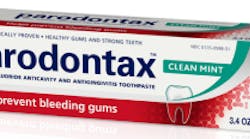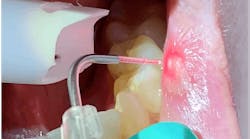The resurrection of Parodontax: GSK's active ingredient is clever marketing
By Chris Bustamante, RDH
Have you ever stopped to consider the power of marketing and the influence it has in our dental lives? Surely, you have. We’re the advocates for optimum oral health after all. What we recommend, our patients buy. One company, and one particular product, seems to have got it right. Because as we all know, when it comes to sensitive teeth, one brand towers above the rest. Yes, that’s right. I’m talking about Sensodyne.
Across the United States and the world, the first response to sensitive teeth starts with that household name we all know so well. While many toothpastes have potassium nitrate as an active ingredient along with the words “sensitivity relief” on the packaging, Sensodyne still reigns supreme as the #1 go-to brand.
Got sensitivity? Get Sensodyne.
But, it goes beyond that in my clinical and personal experience. There is a solidarity among this power brand. Their specialty product, ProNamel, packs a double whammy and is surely the crown jewel of GSK’s product line.
What makes me think that?
One day while scrolling Facebook, I noticed someone had posted about having painful sensitivity from sleeping with their whitening strips on overnight. As I read through reply after reply, I was shocked by the number of people who said, and I quote, “Go get ProNamel. It stops sensitivity and regrows enamel.” As I read these claims, I was a little beside myself. One of them even went so far as to claim that his enamel had melted off and was saved by ProNamel, as if ambulatory in nature. That phrase, “regrows enamel,” burned into my mind.
Ya think?
Clearly, none of these people had a lick of dental IQ, nor do they have any real idea of what is in the tube of paste they use every day. As dental professionals, we know that the sodium fluoride and potassium nitrate in ProNamel is not a magical tooth elixir that can replace enamel that was “melted off” of this man’s teeth. It just doesn’t work that way.
In that moment, it became clear to me that GSK had managed to transcend into a new realm of branding superiority. They completely dominate the niche market of sensitivity relief and enamel-building toothpastes. Their marketing worked like a knife through butter. It’s quite ingenious when you think about it.
Now comes the new contender. Parodontax. The resurrection?
When I first saw this product, I thought it curious that it claims to stop bleeding gums. After doing a little digging, it turns out that Parodontax originated in Germany during the 1930s, and there’s at least one research initiative reported from the early 1990s. The toothpaste appears to be going through a revival of sorts. The original was branded as something with mineral salts and natural herbal extracts. Those specialty ingredients: Mint, mineral salts, chamomile, rattan, myrtle, sage, echinacea with an active ingredient of sodium fluoride 0.31% w/w (equivalent to 1400 ppm fluoride) were listed. Additionally, there were the following inactive ingredients: sodium bicarbonate, aqua, glycerin, cocamidopropyl betaine, aroma, xanthan gum, and sodium saccharin CI77491.
But the new revised version seems to have undergone a transformation in ingredients. The active ingredient is stannous fluoride 0.454% (0.15% w/v fluoride ion). The inactive ingredients are glycerin, PEG-8, hydrated silica, pentasodium triphosphate, flavor, sodium lauryl sulfate, titanium dioxide, polyacrylic acid, cocamidopropyl betaine, and sodium saccharin.
The curious aspect here is that the active ingredient isn’t something revolutionary or new. Crest has been using stannous fluoride in its product arsenal for quite some time, as part of its ProHealth line. The claim by Parodontax is that it works to remove and kill plaque, making it 40% more effective at reducing bleeding gums than traditional monofluorphosphate fluoride toothpaste, when used 24 weeks after a professional cleaning.
While there may not be any real difference in ingredients, the marketing potential of this product is astronomical. People will see this and think, “My gums bleed. I need this.” Even the name is a play on words periodontal, Parodontax, which is fine and well. If it can get people to be more conscientious of their oral health, I’m thumbs up every time. GSK saw the need for another specialty toothpaste and have successfully filled that need.
The only concern I might have is that people will think this toothpaste, like ProNamel, is some sort of magic in a tube. They might assume it has the power to cure their gum disease or that they can simply floss less as a result.
In a double-blind study found on GSK’s “for professionals” website, the anhydrous test dentifrice containing .0454% stannous fluoride was statistically significant superior to sodium monofluorophosphate denifrice in controlling gingivitis (gingival bleeding, BI and visual signs of gingival inflammation, MGI), and surpa-gingival plaque, (PI). The associated p-value was (p<0.0001) with p<0.05 bearing statistical significance.(1)
Stannous fluoride is stannous fluoride is stannous fluoride. The studies on plaque control and bleeding reduction are abundant. No need to beat the horse dead. It works!
Reviews of the Parodontax have shown confidence in the efficacy overall. To date, ratings on GSK’s own website are 4.5/5 (of 65 reviews) and on Amazon 4.3/5 (of 122 reviews), indicating a strong majority in favor of the product. Several of these reviews state the following or similar, “Despite regular dental check-ups and meticulous brushing and flossing, my gums still bled, until I started using Parodontax. No more red, puffy gums. This stuff really works!”
As this product continues to roll out and become better known, it will be interesting to see what type of following this specialty toothpaste will acquire. For some, it might make all the difference. Perception or not, it’s the way of the market and I like how GSK plays the game.
Chris Bustamante, RDH, is a traditional dental hygienist in Denver. His passion for research and his love for writing have transformed his life both personally and professionally. While working toward completing his first science fiction novel, he writes on his personal blog and for various publications. He can be contacted at [email protected].
References:
1. Saxton C, Van der Ouderra FGJ. J Periodontal Res. 1989;24:75.
2. Lobene RR. Clin Prev Dent. 1986;8(1):
3. Lobene RR, et al. Clin Prev Dent 1982:4:5-8.







